
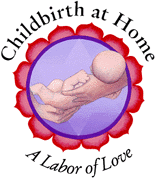

See Also: Wholistic Midwifery and Homebirth | Why Natural Childbirth? | Southern California Birth Support Providers | Questions to Ask When Choosing a Midwife, Obstetrician or Birthing Center.
Birthing Options:
Hospital, Home, or Birth Center? Midwife or Doctor?
by Cordelia S. Hanna, BA, CCE, CBA
| Hospital Birth | Birth Centers | Home Birth | Nurse-Midwives |Doulas (Labor Companions) |Direct- Entry Midwives |
If you wish to have a hospital birth, your chances of having a natural, uncomplicated birth are optimized by carefully selecting your 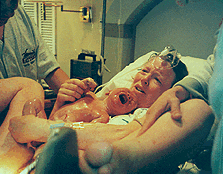 obstetrician and hospital, and by hiring a "Doula" --a Professional Labor Companion. The obstetricians listed in our Providers Directory are supportive of Vaginal Birth After Cesearean (VBAC) and drug-free birth with minimal interventions. Some are used to working with women who hire Professional Labor Companions, and a few of them have assisted clients of homebirth or birth center midwives. Doctors who work with midwives have lower cesearean section rates.
obstetrician and hospital, and by hiring a "Doula" --a Professional Labor Companion. The obstetricians listed in our Providers Directory are supportive of Vaginal Birth After Cesearean (VBAC) and drug-free birth with minimal interventions. Some are used to working with women who hire Professional Labor Companions, and a few of them have assisted clients of homebirth or birth center midwives. Doctors who work with midwives have lower cesearean section rates. 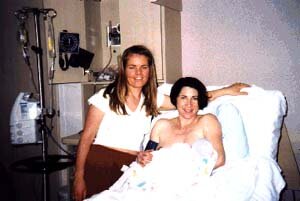
Delivering babies by abdominal surgery has been steadily rising in America over the past two decades, so that now 22% of births in American hospitals are performed by cesearean section. When comparing the U.S. C-section rate to other western,industrialized countries, one finds that those countries which employ midwives for the majority of births have significantly lower rates than ours; and also have lower infant mortality rates and cesearean sections. The U.S., despite having the most advanced technology and highly trained medical personnel, ranks 23rd in infant mortality and 18th in perinatal mortality. That means 23 other countries--most of which have integrated midwives into their maternity care system--lose less babies in the first year of life and between 28 days gestation to 28 days after birth.
The U.S., despite having the most advanced technology and highly trained medical personnel, ranks 23rd in infant mortality and 18th in perinatal mortality. That means 23 other countries--most of which have integrated midwives into their maternity care system--lose less babies in the first year of life and between 28 days gestation to 28 days after birth.
Medical interventions such as epidural anesthesia, pitocin augmentation of labor, vacuum extraction of fetus, episiotomy (cutting of the woman's vagina at the time of delivery) and separation of newborn and mother are standard in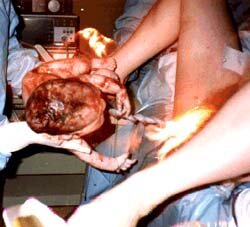 American hospitals. Undoubtedly, there are circumstances where medical procedures such as these are necessary, but many parents and professionals now question the routine use of such interventions such as episiotomy, continuous electronic fetal monitoring, IVs, etc. In many cases, the routine intervention of these procedures leads to "iatrogenic" complications. What this means is that one medical procedure leads to another, the side effects of which create a condition that then requires more medical procedures; this is referred to as "the Domino Effect of Medical Interventions". For example, the epidural anesthetic, while providing pain relief, has been shown to increase cesearean section and vacuum extraction rates significantly, especially in first time mothers. Women considering an epidural should learn about what other medical procedures will be done along with it (catheterization, IV, continious monitoring of baby requiring woman to be in bed on her back, etc.) and what the side-effects and risks are of these procedures to herself and her baby. However, the delimma of "iatrogenic complications" can be mitigated somewhat through education and support from a childbirth educator, professional labor companion or or midwife which will compliment your doctor's medical support. With careful selection of your birthing team and birthplace, it is possible to have a family and woman-centered experience which is natural and normal.
American hospitals. Undoubtedly, there are circumstances where medical procedures such as these are necessary, but many parents and professionals now question the routine use of such interventions such as episiotomy, continuous electronic fetal monitoring, IVs, etc. In many cases, the routine intervention of these procedures leads to "iatrogenic" complications. What this means is that one medical procedure leads to another, the side effects of which create a condition that then requires more medical procedures; this is referred to as "the Domino Effect of Medical Interventions". For example, the epidural anesthetic, while providing pain relief, has been shown to increase cesearean section and vacuum extraction rates significantly, especially in first time mothers. Women considering an epidural should learn about what other medical procedures will be done along with it (catheterization, IV, continious monitoring of baby requiring woman to be in bed on her back, etc.) and what the side-effects and risks are of these procedures to herself and her baby. However, the delimma of "iatrogenic complications" can be mitigated somewhat through education and support from a childbirth educator, professional labor companion or or midwife which will compliment your doctor's medical support. With careful selection of your birthing team and birthplace, it is possible to have a family and woman-centered experience which is natural and normal.
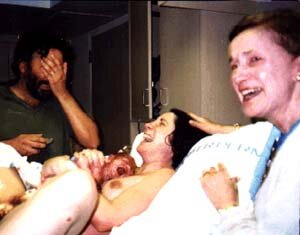
The Certified Nurse Midwife (CNM) holds a Bachelor of Science degree in Nursing (BSN), has passed Nursing Board examinations, has one to two years work in Labor and Delivery in a hospital and has then obtained an Masters degree in Nurse-Midwifery. After completing the Nurse-Midwifery program, the candidate must pass the American College of Nurse Midwives (ACNM) board examination to obtain certification. In 50 states, the Certified Nurse-Midwife can establish a birth center or homebirth practice. But the vast majority work in hospitals. Nurse-Midwives are throuroughly trained in obstetrics, yet treat pregnancy and childbirth as the normal, healthy process it is. 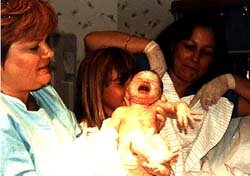 CNMs provide all aspects of prenatal care, labor and delivery and postpartum care independent from the obstetrician; although the obstetrician supervises and consults with the nurse-midwife, and referral can be made if a complication develops. CNMs conduct prenatal exams, prescribe medications, deliver the baby suture, etc. (just about everything short of C-Section or Vacuum Extractor). CNMs are supportive of clients hiring a Professional Labor Companion. A CNM in the hospital setting is a great option for women desiring Vaginal Birth After Cesearean, or natural childbirth. The professional labor companion and/or midwife can help any woman wanting to minimize her need for medication, shorten her length of labor and need for cesearean section.
CNMs provide all aspects of prenatal care, labor and delivery and postpartum care independent from the obstetrician; although the obstetrician supervises and consults with the nurse-midwife, and referral can be made if a complication develops. CNMs conduct prenatal exams, prescribe medications, deliver the baby suture, etc. (just about everything short of C-Section or Vacuum Extractor). CNMs are supportive of clients hiring a Professional Labor Companion. A CNM in the hospital setting is a great option for women desiring Vaginal Birth After Cesearean, or natural childbirth. The professional labor companion and/or midwife can help any woman wanting to minimize her need for medication, shorten her length of labor and need for cesearean section.
Professional Labor Companions ("Doulas")
The Professional Labor Companion (also called a "Monitrice," "Doula," or "Childbirth Assistant") may be a Nurse, Childbirth Educator or specially-trained Birth Partner. Recent studies by Drs. Marshall Klaus, M.D., Phyllis Klaus, M.Ed, C.S.W. and John H. Kennell, M.D. have shown that women who utilize their services have shorter labors, less need for drugs and fewer interventions, including caesarean sections. Professional Labor Assistance is especially beneficial for women desiring vaginal birth after caesarean, but is helpful for any woman who desires a birth with minimal drugs and obstetrical intervention, whether she is single or married, having her first baby or her third. The Professional Labor Companion does not replace the care given by the woman's partner, instead she offers knowledgeable and loving support to both the laboring woman and her partner. Accredition of doulas is by , or Doulas of North America (DONA). In Southern California, doulas can be found at: SoCalBirth.org/providers/support.htm. Studies by Drs. Kennel and Klaus showed that the presence of a professional labor companion reduces the length of labor, need for pain medication, pitocin augmentation, and cesarean section, as well as enhancing mother-baby interaction and breastfeeding success. (For more information see book: Mothering the Mother, by Drs. Kennel and Klaus. For complete list of recommended reading and where to buy books on childbirth, go to: Suggested Reading for Expectant Parents).
have shown that women who utilize their services have shorter labors, less need for drugs and fewer interventions, including caesarean sections. Professional Labor Assistance is especially beneficial for women desiring vaginal birth after caesarean, but is helpful for any woman who desires a birth with minimal drugs and obstetrical intervention, whether she is single or married, having her first baby or her third. The Professional Labor Companion does not replace the care given by the woman's partner, instead she offers knowledgeable and loving support to both the laboring woman and her partner. Accredition of doulas is by , or Doulas of North America (DONA). In Southern California, doulas can be found at: SoCalBirth.org/providers/support.htm. Studies by Drs. Kennel and Klaus showed that the presence of a professional labor companion reduces the length of labor, need for pain medication, pitocin augmentation, and cesarean section, as well as enhancing mother-baby interaction and breastfeeding success. (For more information see book: Mothering the Mother, by Drs. Kennel and Klaus. For complete list of recommended reading and where to buy books on childbirth, go to: Suggested Reading for Expectant Parents).
Freestanding Birth Centers & Water Birth
"Freestanding" Birth Centers are not inside of or affiliated with a hospital, rather they are independently-run by midwives or physicians, often in collaboration. This is an excellent choice for the woman who does not wish to birth in a hospital environment yet is not comfortable giving birth at home. 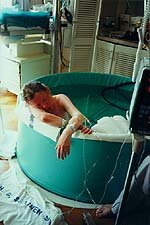 While birth centers do not provide any additional measure of safety than most planned homebirths with qualified midwives, they may provide the expectant couple with the psychological comfort necessary to enable the mother to relax; and wherever a woman feels the most comfortable, she will give birth the easiest. Out-of-hospital birth centers are designed for women having low-risk pregnancies who want drug-free birth with minimal intervention in a home-like environment. Family members may participate in the birth and C-Section rates are lower than most hospitals. Freestanding Birth Centers are an excellent choice for a woman who had a previous cesearean and wishes to maximize her chances of a vaginal delivery. An obstetrician, Licensed Direct-Entry or Nurse-Midwife may attend the birth. Health insurance may cover costs. Many birth centers offer birthing tubs where one can give birth in water.
While birth centers do not provide any additional measure of safety than most planned homebirths with qualified midwives, they may provide the expectant couple with the psychological comfort necessary to enable the mother to relax; and wherever a woman feels the most comfortable, she will give birth the easiest. Out-of-hospital birth centers are designed for women having low-risk pregnancies who want drug-free birth with minimal intervention in a home-like environment. Family members may participate in the birth and C-Section rates are lower than most hospitals. Freestanding Birth Centers are an excellent choice for a woman who had a previous cesearean and wishes to maximize her chances of a vaginal delivery. An obstetrician, Licensed Direct-Entry or Nurse-Midwife may attend the birth. Health insurance may cover costs. Many birth centers offer birthing tubs where one can give birth in water.
| The National Birth Center Study, which was published in the New England Journal of Medicine in December 1989 reported that about 15% of women who begin labor in a freestanding birth center require transfer to an acute care facility, while only 2% require emergency transfer. The others were mainly transferred for slow progress or because the woman requested anesthesia. The overall Cesearean section rate was 4.4%. Over 98% of the birthing women were satisfied with their birth experience. Accreditation for centers is based on carefully designed national standards and is provided by the Commission for the Accreditation of Freestanding Birth Centers. Licensure is provided by individual states. For more information contact The National Association of Childbearing Centers at: 215-234-8068. |
Homebirth With
Types of Homebirth Midwives and Fees
There are two types of midwives who deliver babies at home:
Birth at home provides parents with intimacy, privacy, comfort and a family-centered experience.  Childbirth at home is a safe option for healthy women having normal pregnancies. It is for those who have a very strong desire for natural childbirth and who are willing to take high degree of responsibility for their health care and baby's birth. At home, the parents and midwife are in control of the birthing environment, and strict time perimeters for length of labor are not imposed, or routine medical interventions such as IVs done. "According to recently published studies, direct-entry midwife (non-nurse) attended homebirths were acomplished with safety comparible to that of conventional births. In fact, physician-attended hospital birth has never been shown to be safer than midwife-attended homebirth for women having uncomplicated preganancies". (Citizens for Midwifery, summarizing American Journal of Public Health 1992: 450-453; Birth 1994; 21:141-148), In fact, The World Health Organization (WHO) states that the preferred location for most births is outside the hospital, either at home or in a freestanding birth center.
Childbirth at home is a safe option for healthy women having normal pregnancies. It is for those who have a very strong desire for natural childbirth and who are willing to take high degree of responsibility for their health care and baby's birth. At home, the parents and midwife are in control of the birthing environment, and strict time perimeters for length of labor are not imposed, or routine medical interventions such as IVs done. "According to recently published studies, direct-entry midwife (non-nurse) attended homebirths were acomplished with safety comparible to that of conventional births. In fact, physician-attended hospital birth has never been shown to be safer than midwife-attended homebirth for women having uncomplicated preganancies". (Citizens for Midwifery, summarizing American Journal of Public Health 1992: 450-453; Birth 1994; 21:141-148), In fact, The World Health Organization (WHO) states that the preferred location for most births is outside the hospital, either at home or in a freestanding birth center.
Is Homebirth Safe?
Homebirth midwives provide complete prenatal care including monthly visits, laboratory tests, screening for infections. Unlike obstetricians, they provide nutritional counselling and support for psycho-social issues. In urban areas, emergency services are expeditiously obtainable. While there is the chance that a rare, but critical emergency  might occur during the birth where hospital services may not be able to be obtained quick enough, many complications can be diagnosed and corrected prenatally. Should they occur during the birth or postpartum, they can be remedied by an experienced midwife at the bedside. Homebirth midwives are trained to know when an emergency requires medical interface and can provide stabilizing measures until critical care can be obatined. Homebirth midwives have the training, equipment and medicine to handle complications. For example, the baby's heartbeat is monitored periodically -- which is the way birth attendants evaluate the baby's tolerance for labor contractions-- using a fetal heartrate "auscilation" (listening) device called a doppler or fetal stethoscope. In case of fetal distress in labor or breathing problems after birth, oxygen is brought to the home to give to mother or baby, as well as resuscitation equipment. If a woman has a laceration that needs repair, a midwife is trained in suturing. The homebirth midwife's birth kit includes homeopathic remedies and herbs, medicine to control bleeding, and IV fluid set up. However, many of these interventions, which are routinely used in most hospitals, are used if needed in a home setting.
might occur during the birth where hospital services may not be able to be obtained quick enough, many complications can be diagnosed and corrected prenatally. Should they occur during the birth or postpartum, they can be remedied by an experienced midwife at the bedside. Homebirth midwives are trained to know when an emergency requires medical interface and can provide stabilizing measures until critical care can be obatined. Homebirth midwives have the training, equipment and medicine to handle complications. For example, the baby's heartbeat is monitored periodically -- which is the way birth attendants evaluate the baby's tolerance for labor contractions-- using a fetal heartrate "auscilation" (listening) device called a doppler or fetal stethoscope. In case of fetal distress in labor or breathing problems after birth, oxygen is brought to the home to give to mother or baby, as well as resuscitation equipment. If a woman has a laceration that needs repair, a midwife is trained in suturing. The homebirth midwife's birth kit includes homeopathic remedies and herbs, medicine to control bleeding, and IV fluid set up. However, many of these interventions, which are routinely used in most hospitals, are used if needed in a home setting.

Homebirth midwives have a doctor they consult with or transfer care to in case a complication or emergency develops and transport to a hospital is required. If you don't have insurance, you must be prepared to pay the doctor cash or have a credit card available to pay him or her if his or her assistance is needed. Your midwife may want you to meet with the doctor during the pregnancy, or you may meet him only if a complication arises and a consultation or transfer of care is required.
Insurance and Medi-Cal for Midwives Services
The cost for a homebirth with a midwife in Southern California ranges from $2000 to $3500 for prenatal care, delivery and postpartum visits. Lab tests, ultrasounds birth supplies may be included in the midwife's fee, or may be extra. The midwife's assistant fee and/or childbirth preparation classes may or may not be included.
Some homebirth families who have health insurance may see a doctor for prenatal care concurrently with receiving prenatal care from the midwife in order to establish emergency back up or to have their insurance pay for lab tests and/or ultrasounds, if their insurance won't cover the midwife's fees. Many health insurance companies are now covering homebirths with licensed midwives. In California, state subsidized health insurance, Medi-Cal, may pay for Nurse-Midwifery services through a clinic or hospital. Medi-Cal does not cover Licensed Midwives at this time, although services may be covered in the future. Medi-Cal will not pay for a home delivery, but will pay for pre-natal care and delivery through a clinic, hospital or in some cases a birth center. Persons on Medi-Cal who want a homebirth may obtain prenatal care through a clinic and transfer to the midwife in the last trimester, paying her a reduced fee for a limited number of prenatal and postpartum visits and attendance at the birth.
Renting Tubs for Home Waterbirth
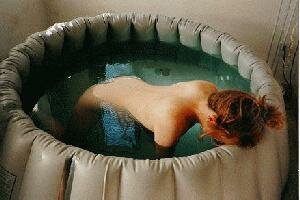 Birthing tubs can be purchased or rented for a birth in water within the privacy and comfort of your own home. To rent a tub, contact Global Maternal/ Child Health Association or go to Karil Daniel's WaterBirth Website Many freestanding birth centers offer birthing tubs, also.
Birthing tubs can be purchased or rented for a birth in water within the privacy and comfort of your own home. To rent a tub, contact Global Maternal/ Child Health Association or go to Karil Daniel's WaterBirth Website Many freestanding birth centers offer birthing tubs, also.
To find a homebirth midwife in your community, contact:
Informed Homebirth
P.O. Box 1733
Fair Oaks, CA 95628
916-961-6923
Request the name of a midwife in your area by E-mailing:
To find a midwife in California, go to: California Association of Midwives Website.
To find out more about midwifery nationally, go to: Citizens for Midwifery website.